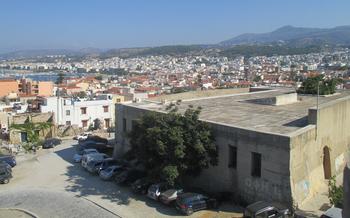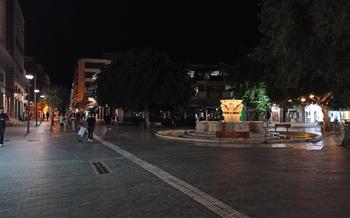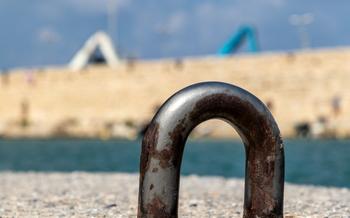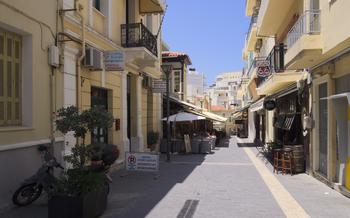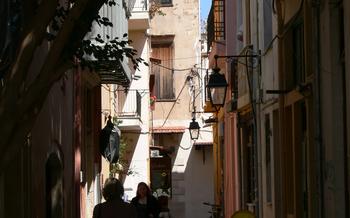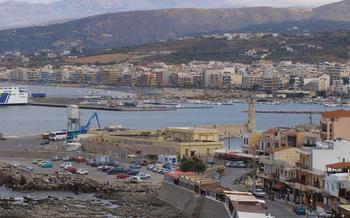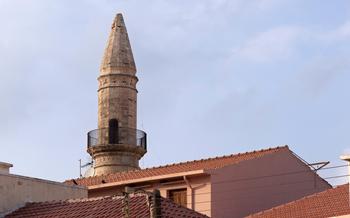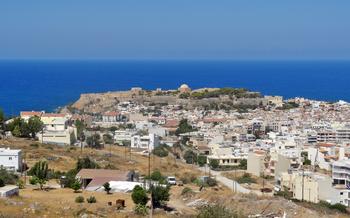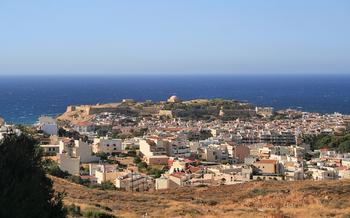
Kourtaliotiko Gorge
- Kourtaliotiko Gorge: A Natural Wonder
- Exploring the Gorge
- The Natural History of the Gorge
- Hiking in the Gorge
- Rock Climbing in the Gorge
- Camping in the Gorge
- Wildlife Watching in the Gorge
- Photography in the Gorge
- Local Cuisine
- History of the Area
- Getting to the Gorge
- Guided Tours
- Insider Tip
Kourtaliotiko Gorge: A Natural Wonder
The Kourtaliotiko Gorge, also known as the Kourtaliotis Gorge, is a stunning natural wonder located in the Rethymno region of Crete, Greece. It is situated between the villages of Koxare and Asomatos, about 25 kilometers southeast of Rethymno town.
The gorge is renowned for its breathtaking scenery, which includes towering limestone cliffs, lush vegetation, and crystal-clear waters. It is a popular destination for hikers, nature enthusiasts, and thrill-seekers, who come to explore its rugged beauty and experience the unique natural wonders that it has to offer.
What makes the Kourtaliotiko Gorge truly unique is its narrow and winding passage, which creates a dramatic and awe-inspiring landscape. The gorge is only a few meters wide at some points, and the towering cliffs on either side can reach heights of over 300 meters. This creates a sense of isolation and wonder, and makes the hike through the gorge an unforgettable experience.
Exploring the Gorge
Exploring the Kourtaliotiko Gorge is an unforgettable experience that offers a unique blend of natural beauty, cultural heritage, and breathtaking views. The hike through the gorge is moderately challenging, spanning approximately 7 kilometers and taking an average of 3 hours to complete. The terrain is mostly rocky, with some steep sections and occasional water crossings, making it suitable for hikers with a good level of fitness.
Before embarking on the hike, it's essential to wear appropriate clothing and footwear. Comfortable hiking shoes or boots with good ankle support are recommended, as well as breathable clothing that can withstand the warm Mediterranean climate. Be sure to bring plenty of water, snacks, and a camera to capture the stunning scenery.
Along the way, hikers will encounter numerous highlights that make the Kourtaliotiko Gorge a must-visit destination. The towering rock formations and lush vegetation create a dramatic and awe-inspiring landscape. Visitors can admire the unique flora and fauna of the gorge, including rare species of wildflowers, butterflies, and birds. There are also several natural pools and waterfalls where hikers can take a refreshing dip or simply relax and soak in the tranquility of the surroundings.
The Natural History of the Gorge
The Kourtaliotiko Gorge is a testament to the power of nature and its ability to create stunning landscapes. The gorge was formed over millions of years by the relentless erosion of the Kourtaliotis River. The river carved its way through the soft limestone, creating a deep and narrow gorge with sheer cliffs on either side.
The geology of the gorge is complex and fascinating. The rocks that make up the gorge are mostly limestone, but there are also layers of sandstone, shale, and conglomerate. The limestone is a sedimentary rock that was formed from the accumulation of shells and other marine organisms over millions of years. The sandstone and shale are also sedimentary rocks, but they were formed from the erosion of landmasses. The conglomerate is a sedimentary rock that is made up of a mixture of pebbles, cobbles, and boulders that were cemented together over time.
The gorge is home to a diverse array of plants and animals. The vegetation in the gorge is mostly Mediterranean, with a mix of shrubs, trees, and flowers. Some of the most common plants include olive trees, carob trees, cypress trees, and thyme. The gorge is also home to a variety of animals, including birds, reptiles, and mammals. Some of the most common animals include eagles, hawks, owls, lizards, snakes, turtles, and foxes.
The Kourtaliotiko Gorge is a unique and valuable natural environment. The gorge is protected by the Greek government as a Natura 2000 site. The gorge is also a popular tourist destination, and it is visited by thousands of people each year.
Hiking in the Gorge
The Kourtaliotiko Gorge offers a variety of hiking trails for visitors of all fitness levels. The most popular trail is the 4-kilometer hike from the village of Koxare to the beach of Preveli. This trail is relatively easy and takes about 2 hours to complete. It follows the course of the Kourtaliotis River and offers stunning views of the gorge walls, the river, and the surrounding mountains.
For a more challenging hike, try the 8-kilometer trail from the village of Asomatos to the beach of Agios Pavlos. This trail takes about 4 hours to complete and involves some steep climbs and descents. However, the rewards are worth the effort, as the trail offers breathtaking views of the gorge and the surrounding countryside.
No matter which trail you choose, be sure to wear comfortable shoes and bring plenty of water. The gorge can be hot and dry, especially during the summer months. It is also important to be aware of the potential for flash floods, especially after heavy rains.
Rock Climbing in the Gorge
The Kourtaliotiko Gorge is a paradise for rock climbers, with a variety of routes to choose from, ranging from easy to challenging. The gorge walls are made of limestone, which provides excellent grip for climbers. The routes are well-maintained and bolted, and there are plenty of places to set up top ropes.
If you're a beginner, there are a number of easy routes to choose from, such as the "Beginner's Wall" and the "Tourist Route." These routes are relatively short and straightforward, and they offer great views of the gorge.
If you're a more experienced climber, there are a number of challenging routes to choose from, such as the "Black Wall" and the "Devil's Chimney." These routes are longer and more technical, and they require a high level of fitness and skill.
No matter what your skill level, you're sure to find a route that suits you in the Kourtaliotiko Gorge. Just be sure to bring your own climbing equipment, as there are no rental shops in the area.
Here are some tips for rock climbing in the Kourtaliotiko Gorge:
- Be sure to wear comfortable clothing and sturdy shoes.
- Bring plenty of water and snacks, as there are no shops in the gorge.
- Be aware of the weather conditions, as the gorge can be hot and sunny during the day, but cool and windy at night.
- If you're a beginner, it's a good idea to hire a guide, as they can help you choose the right route and stay safe.
- Have fun! Rock climbing in the Kourtaliotiko Gorge is a great way to experience the beauty of the natural world and challenge yourself physically.
Camping in the Gorge
Although designated camping areas are not available within the gorge, there are many suitable spots for camping near the entrance and exit points, and in the surrounding areas. The most popular camping option is along the nearby beach of Preveli, offering a breathtaking view of the Libyan Sea. Alternatively, the small villages of Koxare and Asomatos, situated close to the gorge, provide designated camping areas with basic amenities.
Before setting up camp, it's essential to be aware of the local regulations and obtain the necessary permits. Respecting the natural environment is also crucial; avoid disturbing wildlife, using excessive lighting, or leaving trash behind.
The best time to camp in the gorge is during the shoulder seasons (May-June and September-October), when the weather is pleasant, and the crowds are smaller. During the summer months, temperatures can soar, and the gorge becomes busier.
Whether you choose to camp within the gorge or nearby, the experience offers a unique opportunity to immerse yourself in the beauty and tranquility of this natural wonder.
Wildlife Watching in the Gorge
The Kourtaliotiko Gorge is home to a diverse array of wildlife, making it a popular destination for nature enthusiasts and birdwatchers. Some of the most commonly spotted animals include the Cretan wild goat, the golden eagle, the peregrine falcon, and the Egyptian vulture. The gorge is also home to a variety of reptiles, amphibians, and insects, including the endangered Cretan newt and the rare Kourtaliotiko cave beetle.
To maximize your chances of spotting wildlife, it is best to visit the gorge during the early morning or late evening hours, when the animals are most active. It is also important to be quiet and patient, and to avoid making sudden movements that could startle the animals.
Some of the best places to spot wildlife in the gorge include the riverbanks, the cliffs, and the forested areas. The riverbanks are home to a variety of water birds, such as the dipper and the kingfisher. The cliffs are home to a variety of raptors, such as the golden eagle and the peregrine falcon. The forested areas are home to a variety of mammals, such as the Cretan wild goat and the Cretan fox.
If you are interested in photographing wildlife, the Kourtaliotiko Gorge is a great place to do so. The gorge provides a variety of opportunities to capture stunning images of the animals in their natural habitat. It is important to use a telephoto lens to get close-up shots of the animals, and to be patient and wait for the perfect moment to take your shot.
Photography in the Gorge
The Kourtaliotiko Gorge is a photographer's paradise, with its stunning scenery and dramatic cliffs. There are endless opportunities to capture the beauty of the gorge, from the lush vegetation to the sparkling waterfalls.
The best vantage points for taking photos of the gorge are:
- The Kourtaliotiko Bridge: This bridge offers a panoramic view of the gorge, with the towering cliffs rising on either side.
- The Preveli Monastery: This historic monastery is perched on a cliff overlooking the gorge, and offers breathtaking views of the surrounding countryside.
- The Kotsifou Gorge: This smaller gorge is located just a short walk from the Kourtaliotiko Gorge, and offers a more intimate setting for photography.
The best times of the day to take photos are:
- Early morning: The early morning light is soft and golden, and casts a beautiful glow on the gorge.
- Late afternoon: The late afternoon light is also very flattering, and creates a warm, inviting atmosphere.
Some tips for taking great photos of the gorge:
- Use a wide-angle lens: A wide-angle lens will allow you to capture the vastness of the gorge.
- Use a tripod: A tripod will help you to keep your camera steady and avoid blurry photos.
- Experiment with different shutter speeds: A slow shutter speed will blur the water in the waterfalls, creating a dreamy effect.
Some of the most popular photo spots in the gorge are:
- The Kourtaliotiko Bridge: This bridge is a popular spot for taking photos of the gorge, as it offers a stunning view of the surrounding cliffs.
- The Preveli Monastery: This historic monastery is another popular photo spot, as it offers a unique perspective of the gorge.
- The Kotsifou Gorge: This smaller gorge is a great spot for taking photos of the lush vegetation and cascading waterfalls.
Local Cuisine
The gastronomic tradition of Rethymno is a true delight for the senses, offering visitors the chance to savor the authentic flavors of the island and the region. The cuisine of Rethymno is a unique blend of traditional Greek recipes and influences from other Mediterranean cultures, particularly the Venetian and Turkish. Some of the must-try dishes include the famous dakos, a simple yet delicious salad made with barley rusks, tomatoes, feta cheese, and olive oil; gamopilafo, a traditional wedding dish made with rice, lamb, and spices; and tzatziki, a refreshing yogurt-based sauce with garlic, cucumber, and olive oil.
For a truly authentic experience, be sure to visit one of the many family-run tavernas in the area, where you can enjoy fresh, homemade dishes prepared with local ingredients. These tavernas often have charming outdoor seating areas, allowing you to soak up the breathtaking views of the surrounding countryside while you dine.
When it comes to wine, the Rethymno region is home to several excellent wineries, producing a variety of high-quality wines using local grape varieties, such as the Vidiano and Kotsifali grapes. Be sure to sample some of the local wines, which are the perfect accompaniment to a delicious meal.
History of the Area
The Rethymno region has a rich and varied history, dating back to the Minoan period. In the 13th century, the region was conquered by the Venetians, who ruled it for over 400 years. During this time, Rethymno became a thriving port city and a center of culture and learning.
In the 17th century, the region was conquered by the Ottoman Turks, who ruled it for over 200 years. During this time, Rethymno declined in importance, but it remained a cultural and religious center for the Greek Orthodox population.
In the 19th century, the region was liberated from Turkish rule and became part of the newly independent Kingdom of Greece. Since then, Rethymno has experienced a period of growth and prosperity. Today, it is a popular tourist destination, known for its beautiful beaches, its Venetian architecture, and its rich history.
Some of the most important historical sites in the Rethymno region include the Venetian fortress, the Archaeological Museum of Rethymno, and the Historical and Folklore Museum of Rethymno. The Venetian fortress is a particularly impressive sight, and it is one of the best-preserved examples of Venetian architecture in Greece. The Archaeological Museum of Rethymno houses a collection of artifacts from the Minoan, Roman, and Byzantine periods, while the Historical and Folklore Museum of Rethymno tells the story of the region's history and culture.
Getting to the Gorge
The Kourtaliotiko Gorge is located about 20 kilometers south of Rethymno. To get to the gorge, you can either drive or take public transportation.
If you are driving, take the E75 national road and exit at the Kourtaliotiko Gorge exit. From there, follow the signs to the gorge. The drive from Rethymno to the gorge takes about 30 minutes.
If you are taking public transportation, you can take the bus from Rethymno to Plakias. From Plakias, you can take a taxi or the local bus to the gorge. The bus ride from Rethymno to Plakias takes about 1 hour and 15 minutes. The taxi ride from Plakias to the gorge takes about 15 minutes.
The cost of transportation to the gorge varies depending on the mode of transportation. If you are driving, you will need to pay for gas and parking. If you are taking public transportation, you will need to pay for the bus fare and the taxi fare.
Guided Tours
Exploring the Kourtaliotiko Gorge with a guided tour offers several advantages. Experienced guides provide insightful commentary on the gorge's history, geology, and ecology, enhancing your understanding and appreciation of the natural wonder. Guided tours often include transportation to and from the gorge, eliminating the hassle of arranging your own transport. They also ensure your safety by providing necessary gear and monitoring the group throughout the hike.
However, guided tours come with a cost, typically ranging from €20 to €50 per person. Additionally, group tours may limit your flexibility and spontaneity, as you'll need to adhere to the group's pace and itinerary. If you prefer a more personalized and intimate experience, consider hiring a private guide who can tailor the tour to your interests and fitness level.
Whether you choose to go with a guided tour or explore independently, the Kourtaliotiko Gorge promises an unforgettable adventure. With its stunning scenery, rich history, and diverse wildlife, it's a must-visit destination for nature enthusiasts and adventure seekers alike.
Insider Tip
The Kourtaliotiko Gorge is a true hidden gem, but it can get crowded during the summer months. To avoid the crowds, try to visit in the shoulder season (May-June or September-October). The weather is still warm and sunny, but there will be fewer people on the trails.
Another insider tip is to bring a pair of water shoes. The riverbed is rocky in places, and water shoes will protect your feet from sharp stones. If you're planning on swimming in the gorge, you'll also need to bring a swimsuit and towel.
Finally, don't forget your camera! The Kourtaliotiko Gorge is a photographer's paradise, with its stunning scenery and dramatic rock formations. Be sure to capture the beauty of the gorge in your photos so that you can share it with your friends and family.
